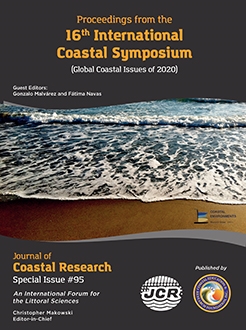Coelho, C.; Ferreira, M., and Marinho, B., 2020. Numerical modelling of artificial sediment nourishment impacts. In: Malvárez, G. and Navas, F. (eds.), Global Coastal Issues of 2020. Journal of Coastal Research, Special Issue No. 95, pp. 209–213. Coconut Creek (Florida), ISSN 0749-0208.
In general, coastal erosion problems are related to significant sediments deficits. A possible coastal erosion mitigation strategy involves restoring the sediments balance through artificial nourishments. However, the complexity of the physical processes in the coastal zones challenges the numerical tools prediction capacity. This is usually overcome through numerical modelling of the shoreline evolution and the cross-shore profile along time, as an attempt to anticipate the performance of nourishments operations. The coastal morphology depends on the sediments dynamics and the incident wave climate is considered the main modelling agent responsible for the potential sediment transport capacity. The cross-shore sediment transport is usually associated to the shortterm behaviour of the morphological evolution of the beach (seasonal changes) and the longshore sediment transport is related to the long-term changes (towards an equilibrium state). Typically, these distinct sediment transport components are studied and modelled separately due to the incompatibility of their time scales of interest.
This work was developed to numerically model the impact of artificial nourishments. LTC (Long-Term Configuration, Coelho, 2005) and CS-model (Larson et al., 2016) were both applied to analyse the spatial and temporal distribution of sediments induced by artificial nourishments along and across the shore, considering different intervention scenarios. LTC was applied to evaluate the nourishments impact in the shoreline evolution and to quantify the volume of nourished sediments in different longshore locations along time. The CS-model was used to analyse the performance of multiple intervention scenarios, varying the cross-shore location, frequency and volume of the artificial nourishments. The performance of this type of intervention generally represents a smaller shoreline retreat and an increase of the cross-shore profile volumes during a limited period of time. The project results aim to increase numerical modelling capabilities, helping on the selection of optimal artificial nourishment schemes and the establishment of more efficient coastal management policies.





